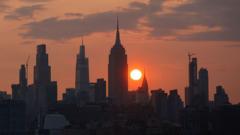New York City is under an air quality health advisory after smoke from ongoing wildfires in Canada drifted southward, impacting air conditions in the region. The New York State’s Department of Environmental Conservation (DEC) and the Department of Health (DOH) announced the advisory on Saturday for areas including Long Island, the New York City Metro, Lower Hudson Valley, Upper Hudson Valley, and the Adirondacks. Authorities are informing residents that air quality in these regions is deemed "unhealthy for sensitive groups."
These wildfires in Canada have already forced tens of thousands of residents to evacuate, with the smoky conditions raising significant air quality concerns across northern parts of the United States. Predictions for the air quality index (AQI) indicate levels may soar above 100 in New York state, possibly approaching 135. Similar alerts have also been issued across parts of New England.
The AQI is a crucial measure detailing pollution severity and associated health risks—the higher the index, the greater the risk individuals face when breathing contaminated air. This latest advisory aligns with previous alerts, including one issued earlier this month for Chicago, where special precautions were recommended for vulnerable populations such as infants and the elderly.
Political repercussions have ensued, with six members of Congress voicing concerns to the Canadian ambassador, citing diminishing summer enjoyment for Americans due to smoke from the wildfires.
Currently, there are over 550 active wildfires raging in Canada, primarily concentrated in Manitoba. Over the past year alone, approximately 6.1 million hectares (15 million acres) of land have been scorched. The months of May and June proved particularly devastating, as nearly 30,000 individuals evacuated their homes in Saskatchewan and Manitoba, prompting local governments to declare states of emergency.
Scientists continue to tie the increasing severity of wildfire seasons to climate change, with Canada reportedly warming at twice the rate of the global average, and its Arctic regions heating up at nearly three times that pace, raising alarms among experts. The situation remains fluid as officials monitor the ongoing disaster and its far-reaching effects across borders.






















